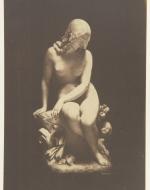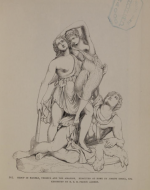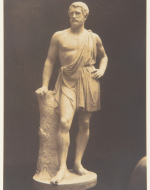Created by Amanda Francis on Mon, 03/03/2025 - 07:30
Description:
Marble statues at the Great Exhibition of 1851 were a testament to artistic excellence, national prestige, and the enduring influence of Neoclassicism within Victorian culture. They reflected the era’s admiration for classical antiquity and its emphasis on moral, historical, and allegorical themes. The exhibition also became a platform for engaging with contemporary social issues, including the abolitionist movement, which was gaining momentum in both Britain and America. Sculptures like Hiram Powers’ The Greek Slave were interpreted not just as neoclassical art, but as powerful visual metaphors for the horrors of slavery and the dignity of the enslaved. The figure’s nudity, chains, and Christian symbolism appealed to Victorian values of modesty, faith, and moral righteousness, allowing viewers to confront the cruelty of slavery through an acceptable aesthetic lens. The meticulous craftsmanship required to carve marble further aligned with Victorian ideals of discipline, refinement, and cultural advancement.
Beyond their artistic significance, these sculptures played a crucial role in shaping Victorian taste and social ideals. The exhibition made fine art more accessible to the public, introducing audiences to classical notions of beauty, virtue, and idealized human form—concepts deeply embedded in Victorian morality and aesthetics. Notable works, such as The Greek Slave, which stirred abolitionist sentiment and Victorian ideals of purity and suffering, and Raffaelle Monti’s veiled figures, which amazed viewers with their illusionistic carving, captivated audiences with their craftsmanship and deeper symbolism. These sculptures embodied the Victorian era’s fascination with storytelling, sentimentality, and the power of art to engage with contemporary moral and political issues.
Booth for Marble Statues at Our Great Exhibition of 1851, created by Amanda Francis, 2025. This booth is based on the drawing from the London Museum. The background image depicts the marble statues lining the walkways of the Great Exhibition, welcoming the guests with artwork from different countries. I decided to depict the three most major pieces of art that I have studied in this project. The first I glued to the image was Eve by Monti as a representation of the importance of Christian faith in the Victorian period. The next was Iconic Statue by Macdonald, depicting the aesthetic value of Neoclassicism of the Victorian age. Finally, I mounted The Greek Slave by Powers to stand on its own to depict the importance of the statue to the exhibition and to the history of the abolitionist movement as a whole. I created this scene using colored paper and recycled carboard, creating a 3D scene to feel as though you are walking amongst the statues of the Exhibition.
Raffaelle Monti, Eve, Volume IV (RCIN 2800003) of "Exhibition of the Works of Industry of All Nations, 1851: Reports by the Juries on the Subjects in the Thirty Classes into which the Exhibition was Divided," Photo by Claude-Marie Ferrier (1851), courtesy of the Royal Collection Trust. Description from the Royal Collection Trust: "Photograph of a marble statue depicting Eve after the Fall. The female figure sits unclothed on a rock with her right leg tucked behind her left. Her left arm falls across her torso and rests on her right thigh. She supports herself with her right arm. She looks down towards a child peeping from behind the rock on the right." This statue is reminiscent of the Victorian values surrounding the Christian faith. Christianity was treated as law in the Victorian age, and women specifically were expected to act with God in mind. This sculpture is a representative of the feminine shame involved with religion and the pressures of being a woman within the Victorian era.
"Group in Marble, Theseus and the Amazons." 1851, Joseph Engels, esq., exhibited by H. R. H. Prince Albert, in Great Exhibition of the Works of Industry of all Nations, 1851, Official Descriptive and Illustrated Catalogue, Volume I. This illustration depicts a marble statue presented by Joseph Engels under the patronage of Prince Albert. The central male figure, Theseus, is muscular, partially draped, and positioned in a dominant stance, gripping one of the female figures. One woman leans backward with her head tilted, her flowing garment draped over her body, while the other is lifted, her legs bent and arms reaching out. This statue depicts the typical structure of gender hierarchies within the Victorian era: the men being depicted as heroes while the woman stay as accessories to his being.
Lawrence MacDonald, Iconic Statue, Volume IV (RCIN 2800003) of "Exhibition of the Works of Industry of All Nations, 1851: Reports by the Juries on the Subjects in the Thirty Classes into which the Exhibition was Divided," Photo by Claude-Marie Ferrier (1851), courtesy of the Royal Collection Trust. This is a description from the Royal Collection Trust: "Photograph of a marble statue of a bearded male figure standing, wearing a chiton and sandals. His right leg is placed forward and he rests his left hand on his hip. He places his right hand on stump located beside him." This statue by MacDonald, while simple, depicts the aesthetic values of Neoclassicism. With everything new and industrial being presented at the exhibition, visitors enjoyed appreciating all that is familiar to them. Therefore, statues reminiscent of the Greeks and Romans towered over visitors as they walked through the Exhibition.
Hiram Powers, The Greek Slave. 1846. Corcoran Collection (Gift of William Wilson Corcoran) of the National Gallery of Art. Hiram Powers' The Greek Slave, modeled between 1841 and 1843 and carved in 1846, is a significant marble sculpture in American art history. Standing approximately 65 inches tall, it portrays a nude Greek woman in chains, symbolizing her enslavement by Ottoman captors during the Greek War of Independence. Her restrained posture, with one hand modestly covering her nudity and the other resting on a support draped with a cloth, conveys both vulnerability and dignity. The inclusion of a cross and locket among the drapery suggests her enduring faith and personal loss. As mentioned in the narrative above, this statue was the most visited statue of the Exhibition for its importance within the abolitionist movement in America. With the exhibition being a meeting spot for many abolitionists, this statue combined the Victorian ideals of Neoclassical aesthetics and the horrors of slavery to help convice the Victorian visitors to understand the purpose behind the abolitionist movement. With it being the most visited art piece of all listed above, the combination of ideals was effective in creating a lasting impression on Victorian society, making visitors question the nature of slavery and the ideals behind each of these statues to begin with.






